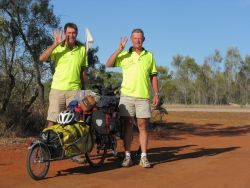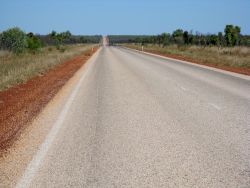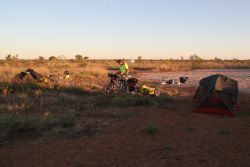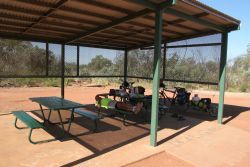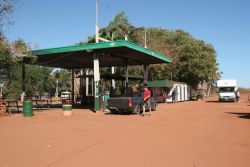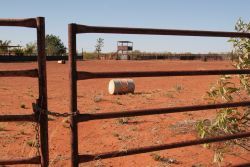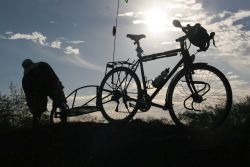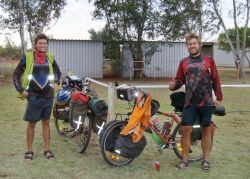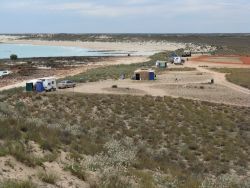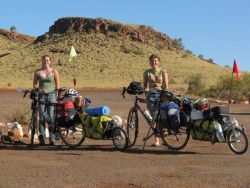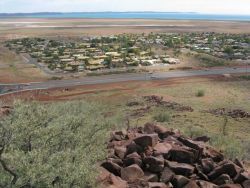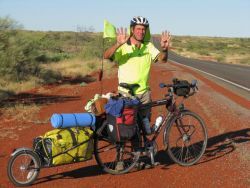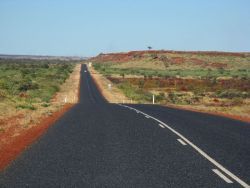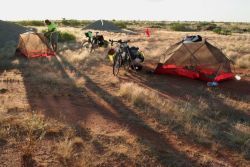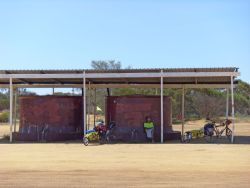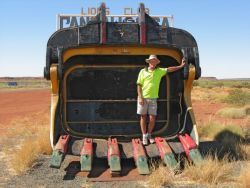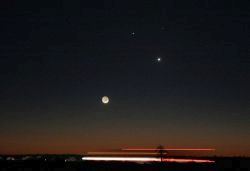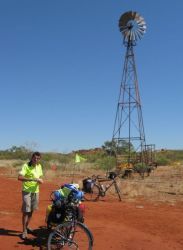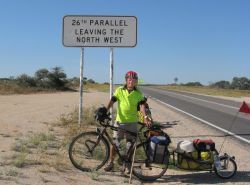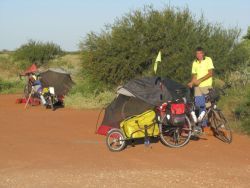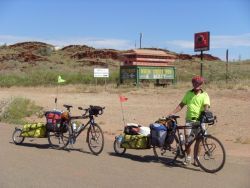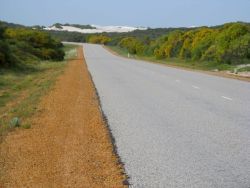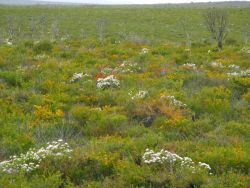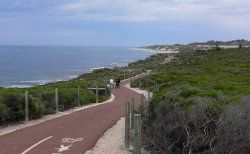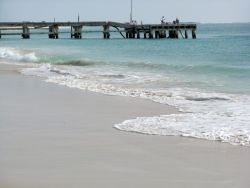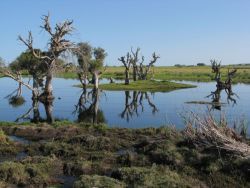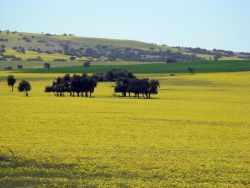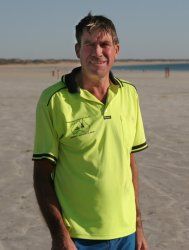(click on any picture for a larger version)
Water insurance
Throughout the trip we took pride in being largely self-sufficient in water between caravan parks and other stopovers. We each carried 6 to 8 x 1.5 litre PET bottles in the trailers, and a further 1.5 litres in the drink bottles on the bike frame, a total of up to 13.5 litres, which was enough for a two day leg, and generally we had at least a couple of full PET bottles left over at the end of the second day. A couple of times I did ask a caravanner for a couple of litres to top up the stocks but it was opportunistic rather than necessary.
There were two legs of 290km each with no facilities of any sort, one from Halls Creek to Fitzroy Crossing, the second from Roebuck Plains Roadhouse near Broome to Sandfire Roadhouse. The first of these legs didn’t present a great problem, as the winds were a constant easterly and riding 145km with a tailwind was quite do-able.
However after Broome, we knew the fickleness of the coastal winds might be a problem, if we encountered a headwind of any severity we could well have to pedal for three days to get down to Sandfire Roadhouse. We got talking to a couple in a motor home who were heading down to Sandfire and asked them if they could take some extra water for each of us and drop it at the halfway point in a rest area, to which they gladly agreed.
Sure enough, as we headed south, we encountered partial headwinds which slowed our progress quite markedly, and we camped a bit short of halfway. By the time we had cooked rice and had a couple of mugs of tea, we were down to under 4.5 litres each, which would have been just enough to last until sundown the next day, and if we needed to camp overnight we would be getting mighty thirsty.
The next day once again saw headwinds and with the dry air and the exertion of pedalling constantly, the drinking bottles were fast emptying. We reached the rest area where we had arranged for the extra water to be dropped off, and as we rode up to the shelter a glorious sight awaited us, two clear plastic water containers untouched and full of sweet water. It was such a comfort to have adequate water no matter what.
We did make Sandfire roadhouse at the end of the day, and we would have made it without the extra water, but it would have been touch and go to finish with any water at all. As it was, we were able to fill all our bottles and drink as much as we liked to ward off dehydration. So a big thankyou to the kind couple who took the trouble to give us much-needed insurance for the longest and driest leg of the whole ride.
At no time on the ride were we ever really worried about running out of water, even if we faced a major delay. Although we could only carry enough for two days and one night, there was a constant presence of caravans and motor homes along the road, and at almost every rest area there would be at least one pulled up having a rest. We knew that if we did get into strife through delays or adverse winds, there would always be someone passing by who could give us enough to see us through.
Young bucks doing the tour
South of Sandfire Roadhouse is the equally remote Pardoo Roadhouse. While we were relaxing in the late afternoon a couple of brothers, Tim and Will, pulled in on their mountain bikes. Their bikes and kit were a lot more basic than ours, with lots of things having the duct tape repair option, and it appeared their budgeting was a lot tighter than ours. So tight in fact that they hadn’t been eating properly and consequently the younger one, Will, was sick, lacking colour and energy. I think they both realised he was in danger of doing some damage if he continued to ride on little more than packet noodles. A bunch of Pilbara miners on a fishing trip were heading into Port Hedland 150 km away and convinced him to accept a lift, while Tim chose to ride the distance.
The amazing thing about these two was how Tim became involved. Apparently Will had decided to ride around Straya for something to do, as he had no commitments it was quite an easy decision. Tim couldn’t let his younger brother go alone on such a potentially hazardous undertaking and chucked in a job and a relationship (if I remember correctly) to look after his sibling. Not sure what degree of planning they undertook, especially financial, but they were not only surviving, having a once in a lifetime adventure. Being young and tough, they could keep going on a diet that would have seen us falling by the wayside. It certainly brought home the bacon (so to speak) as to the necessity to eat big solid roadhouse dinners whenever we could. We occasionally heard that they were progressing well down the WA coast, but we lost contact after Perth.
Almost a symbolic loss
While at Pardoo Roadhouse, we had the luxury of over half a day to kill so we rode 12km on a heavily corrugated dirt road to check out the Indian Ocean. The riding, even on empty bikes, was a right royal pain, but we did enjoy getting on to the beach and marvelling at the vast emptiness we shared with several dozen campers and caravanners. On the way back I was lost in the task of picking the least uncomfortable track along the road, and after a while I noticed that Pete wasn’t anywhere to be seen.
Figuring he had a puncture I stopped and waited, and waited, until eventually Pete appeared as a speck in the distance, gradually getting closer. Turned out the orange warning flag that was mounted on his rack had fallen off, so he had retraced his steps to find it. Murphy was obviously around, because the flag was located near where we had stopped at the beach, about as far back as it was possible to get. It wasn’t just that the flag was used as a visual cue for vehicles behind us, it was also a symbol of the ride, and if it had not been found it would have been more than just a triangle of sailcloth lost. I certainly did sympathise with Pete, it was bad enough negotiating those horrible corrugations once on our unsuitable bikes, twice would have been truly horrendous.
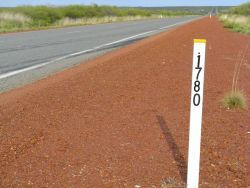 |
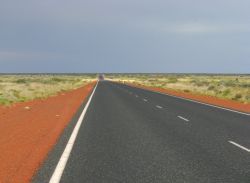 |
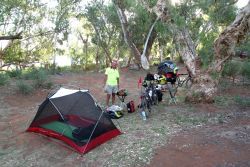 |
|
Road gang markers counting down the km all the way to down near Perth |
Often it seemed the whole world belonged just to us |
Camping at De Grey River north of Port Hedland. |
Catching up with cohorts from Coco’s
Further down the WA coast, on an isolated stretch of Pilbara road, we were cycling along minding our own business, heading for the
Fortescue Roadhouse and a selection of ginger beers and flavoured milks, as we always looked forward to in the heat and dryness. With only 15 kms to go, or nearly an hour in cycling terms, a car came past and pulled over. This hadn’t happened since a vanning couple chose to donate on the side of the road back on the east coast, so our interest was piqued as to the nature of this intrusion into our routine,
Then, to my surprise, as I rode up to the driver’s window I saw a familiar face, in the form of Louise, a backpacker whom we had met and had numerous conversations with back in Katherine. She was heading for Exmouth for a few days with another friend Christine. It was only another 40 odd minutes to the roadhouse so we agreed to meet there for a drink and a catchup. It was quite surreal pedalling on after they had disappeared up the road, towards a roadhouse where, for the first time on the trip, we would actually know someone on arrival.
After a couple of hours and a long cold ginger beer or two we reluctantly said goodbye to the two travellers, who still had a long drive at the end of the day to look forward to, and we returned to the now mundane task of setting up the tents and choosing the biggest dinner on the menu before turning in just after dark.
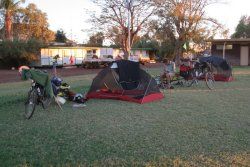 |
|
The impression of a
luxurious lawn may |
That’s not what you asked
Fortescue River Roadhouse had a really nice piece of lawn for us to pitch our tents, and for some reason Pete decided not to peg his down, relying on the weight of the contents to keep it in place. During the night the wind freshened and was quite blowy when it was time to stir and head for the showers.
Pete returned from his shower to an empty patch of grass. Initially he thought I must have packed his tent up for some reason but quickly realised the wind provided a better explanation. It would have been easy for a good gust to take the tent off between the cabins so Pete walked off downwind and on the way asked a lady in a dressing gown heading for the shower block if she had seen a tent blowing down her way. “No” she replied with a lot of conviction shaking her head. The tent wasn’t anywhere to be seen and Pete wandered back towards our site, by now quite worried about the possibility of having lost his tent. As he passed the shower block again, the same lady came out and matter-of-factly said “Come to think of it I did see one blowing that way”, pointing in another direction. After some searching he found his tent against the fence in the direction she pointed.
To this day no-one has been able to figure out why she didn’t mention it when Pete first asked rather than several minutes later.
Getting to know road trains
After several months of being out on the road we became attuned to the vagaries of the traffic and we were able to pick the type of trucks that were approaching, and often the way the sounds behaved at night gave us a clue as to the likelihood of favourable winds the next day.
A large road train labouring along a lonely highway can be heard from a long way away. Often in a bush camp we would hear the trucks going one way for up to 15 minutes before they passed by, while ones travelling in the opposite direction might not be heard until only a minute or two away. We were able to judge the movement of the wind this way even if there was little or no breeze at the campsite.
During the day, we also became adept at knowing when we could relax a little and when to be vigilant. If the wind was on our tails we didn’t need to worry about keeping constantly alert for vehicles from behind, as we would hear even the quietest cars well before they passed, and road trains, identifiable by their signature deep resonance, would appear ages after we first heard them. Conversely, any sort of moderate to strong headwind meant that almost all vehicles couldn’t be heard until the last moment, and more than once we were taken by surprise by trucks zooming past that we just had not heard. After a while it became second nature to keep one eye on the rear view mirror on headwind days.
There was something about lying in the tent with a million stars visible through the mesh, not a sound to be heard except for the faint engine note from a fully laden road train approaching from an unknown point in the distance, passing by and gradually fading off as the driver, alone in the dark, disappeared along with the connection to the rest of the world, and once again the silence of the outback night was allowed to descend over the pitch black landscape.
Carnarvon, windy one day, blowy the next
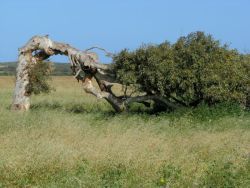 |
|
This tree was
actually closer to Perth but |
Paul Elwood in his comprehensive guide ‘Around Australia By Bicycle’ warns that the west coast of WA will make or break the circumferential cyclist, and so it proved to be. We had encountered varying winds all the way down from near Broome, and most days had some favourable and some unfavourable winds. We pulled into Carnarvon for a layover in fairly light winds, but over the next two days the wind sprang up from the south and didn’t look like it was going to abate.
After a blowy day and night, with the wind roaring through the palm trees at the caravan park, I would have been happy to not get going, but with no idea when the southerlies might end, we knew we had to get going and get as many kilometres as possible under the tyres. Over the first few kms we had a strong sidewind as we headed east to meet the highway, progress was annoyingly slow and the buffeting from the gusts wasn’t pleasant. Then it was time to turn south, into the teeth of the wind. Luckily the countryside around Carnarvon is blessed with shrubs, mostly head high, to take the sting out of the wind. Even with the protection of the vegetation the headwind was in the order of 30km/hr, which slows us on the flat from a possible 23km/hr to 13km/hr, and in areas where the vegetation was a bit sparse, we could only manage 11km/hr on the speedos.
Talk about frustratingly draining of spirit. All we could do was put the heads down, concentrate the mind on something other than the evil headwind, and pedal. After five hours of pedalling (with a couple of wind-blown tea stops) the wind had increased further and we were starting to see less than 10km/hr despite pedalling hard. We parked the bikes at one point and crawled in under the waist high bushes to get some shade as the unrelenting wind continued to blow. After a while we tried again and at 78kms from Carnarvon and a full day’s effort, we came across a rest area that amazingly had shrubs greater than 2m in height, and a rotunda to relax in. Relaxing’s not the right word when the wind is constant and unremitting, but at least it was better than having to camp between the low shrubs of the rest of the countryside. The stopover was quite a good spot and would have been even better if some pea-brained fishermen, out to prove that no-one gets a quiet stop when they're around, came in and camped and while getting ready to leave at 4am made sure their juvenile commercial radio station was played loud enough to be heard right up the other end of the rest stop. Made me wonder if arrogance is seen as a virtue in the bogan classes.
The wind slowly abated overnight and next day we had a 42km leg into Wooramel Roadhouse with a wind that back home we would have called a good headwind, but out in the Carnarvon plains seemed to be almost a calm day.
Overall we had reasonable luck with the WA winds, they continued to be mostly headwinds right down to Perth, but often we were granted a tailwind for half a day. Compared to horror stories we’ve heard of facing strong headwinds day after day we got off lightly. Had we encountered a week of such winds, I might have been tempted to leave a little gap in the map so to speak, and load the bike on a truck for a leg or two. Luckily it didn’t come to that and Sydney remains as the only blank portion of the whole ride.
Australia’s stupidest insects
Insects are not smart, we know that, though most have an ability to avoid crashing into solid objects other than windows. Occasionally an out of control blowfly would bounce off the helmet but in general only the bush flies were ever noticed.
That is until we emerged from the scrub around Northampton north of Geraldton. The vast open grainfields heralded a new annoyance in the form of stupid insects. Every so often on an otherwise unremarkable stretch of road we would ride through clouds of tiny black insects that did not appear to have sense that we were approaching and although the majority bounced off our clothes and bikes, a lot didn’t and we often had hundreds of the little buggars to brush off when we stopped. I had carried a pair of sunnies in my handlebar bag all the way from Canberra, but it wasn’t until this point that I finally put them on, and it wasn’t because the sun was too bright!
We rode through the thickest clouds of these flying kamikazes just before we rejoined the Brand Highway east of Jurien Bay. On a long downhill run to the intersection it was similar to how I would imagine riding through the rice confetti thrown at weddings these days.
As we left the SW corner of WA we never again struck anything similar despite the continuing grainfields so it would appear to be a localised species.
Flukey winds into Perth
The ride down to Perth from the Willowbrook Caravan Park highlighted the fickle nature of the WA coastal winds. As we headed down towards Wanneroo Road we were pedalling into a westerly headwind which we assumed would gradually get stronger. Not long after turning south, the load on the pedals started to get lighter, and the wind died off somewhat. Another few kms and we noticed still less work to do, as the wind began to pick up from the north, fairly blowing us down towards the northern edge of Perth at better than 30km/hr on the tail.
Just as we got to the suburban edge, the wind swung westerly again and a big black cloud threatened rain, so Pete suggested we head into the suburb to find some shelter, which we did soon enough in the shape of a sports pavilion at an oval. As we arrived at the shelter the rain came beating down for perhaps a quarter of an hour, but quickly passed by to be replaced with sunny breaks. We had to beat our way into the strong westerly to get to the start of the cycle path which wound its way through the seaside dunes towards our destination near Fremantle. Once on the cycle path we gained a little assistance from the slightly northerly bias of the still strong wind, and as we approached Scarborough rain showers drifted across so we took shelter at a maritime safety HQ. As we sheltered under the roofline we invited up into the control tower and had a very informative hour or so with the duty staff.
The wind by this time had increased further and for while I was enjoying leaning into a 50km/hr onshore wind between rain squalls. Once the front had passed the wind slowly settled down and by the time we got to Cottesloe there was just a light breeze to keep us company. I guess Perth dwellers wouldn’t find anything unusual in the weather patterns described here, but for us as Canberrans and having had mostly stable weather patterns for months, it was quite an eye-opener.
Perth well served by cycleways
Of all the cities we had actually ridden through Perth was the most cycle-friendly, Brisvegas the least. Sydney might well have claimed that title from Brisvegas but as we had elected to utilise the safety of the suburban trains through to Hornsby, we’ll never know for sure.
Starting right up at Wanneroo, we followed a cycle path, almost continuously for 35kms down to Cottesloe, then after meeting our accommodation host Greg for further directions to Attadale, and a few kms of the Stirling Highway to get over the Swan River, we had the option of a riverside cycleway for the rest of way into Attadale. (I think we might have taken the road at this point as it was more direct.)
For the rest of our five days off in Perth we discovered a whole network of cyclepaths, all clearly marked, often colour coded, and in almost all cases going right where we wanted to go. Going into the city? Jump on the cycleway just down the bottom of Attadale and follow it right into the city. Off to Fremantle? Jump onto the same path going the other way, negotiate a few roads in Fremantle proper and join the coastal cycleway south to at least North Coogee.
The best thing about the Perth cycleways was their lack of interaction with the traffic. Most of the sections did not cross more than an occasional road so once the bike had built up speed it was easy to maintain 30km/hr or so for most of the journey. Full points to the visionaries who established the Perth cycleway network, it’s brilliant!
Pete the tradie not good enough
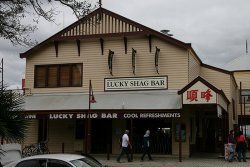 |
|
The Lucky
Shag Bar in Perth, where the cream of |
Pete was in town checking out the city centre while I was off in Fremantle I believe, and spotted an eatery down by the river, called The Lucky Shag. After making himself comfortable and ordering a lunch, Pete was surprised when a waiter came over and said he had to leave. He thought it was a good joke and was getting into the humorous spirit when he realised the waiter was serious. Seeking a second opinion from the manager he was told the same thing. His crime? Wearing the fluorescent yellow-green riding shirt, printed front and back with the charity ride logos. When Pete explained the significance of the shirt he assumed they would capitulate this being a charity ride and all but the manager was not swayed, Pete’s shirt had to go. Not having anything else to wear Pete offered to remove the shirt but a bare chest wasn’t allowed either. Apparently, according to the manager of the fine culinary institution, if Pete was allowed to eat there, the tradesmen working on a nearby construction project would also have to be allowed access to the fine food. Pete’s comment that tradesmen have to eat too fell on deaf ears.
So good travellers be warned, if you darken the doors of some of Perth’s more precious establishments, you’d better not be wearing clothes that show you do a good day’s physical work for a good day’s pay, or you won’t be good enough for the tossers who preen themselves to impress CBD wankers.
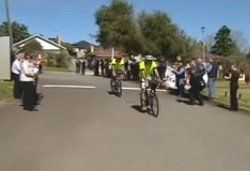 |
|
Screenshot from a
Channel Ten story on Pete's
|
Unexpected welcome
As part of Pete’s fund raising efforts for Cerebral Palsy Pete received an invitation to meet one of CP Australia’s ‘cover girls’ at a meet and greet morning tea. We rode the 20 odd kms via the CBD to Coolbinnia to the Centre for Cerebral Palsy where Pete was to meet young Paris Donald, whose photo he had used in the artwork for our fluoro riding shirts. As we rode down the final hill towards the centre, we assumed we would just ride in and knock on the door.
But the sight that greeted us was out of this world. About 50 staff members and supporters were lined up each side of the entrance along the driveway and applauded as Pete (with me following) rode in. They had also arranged for Channel Ten News to cover the event, and they spent quite some time putting together a very empathetic story for the 6 o’clock news. Although our spirits were already quite high on the trip, this gesture of appreciation by the recipients of the fundraising certainly lifted them even higher and somehow made each push on the pedals from then on just a bit lighter.
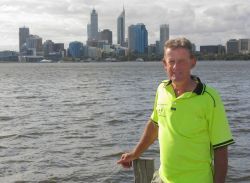 |
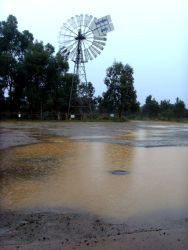 |
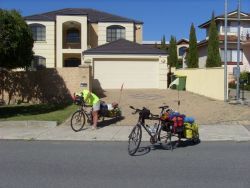 |
|
The skyline of Perth from the other side of the rivers, home of the SORs (click for explanation) |
From Atherton QLD to near Geraldton we didn't see any of this stuff at all. Two and a half straight months of clear blue skies |
While swanning around Perth we stayed at friend Greg's little cottage. Gotta slum it sometimes I guess. |
